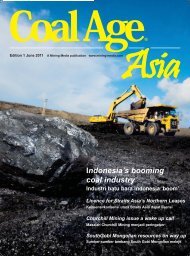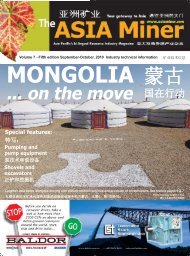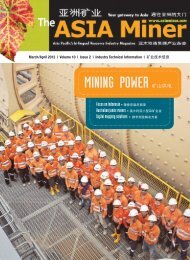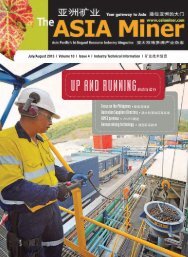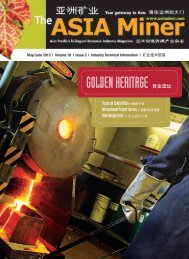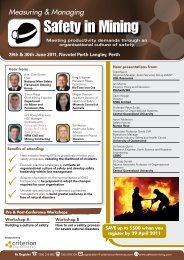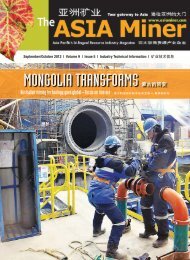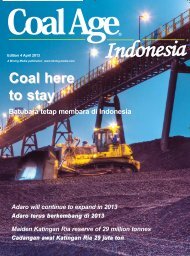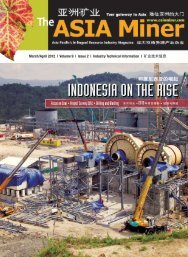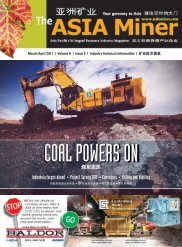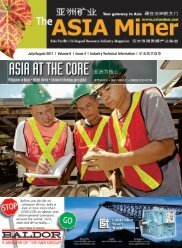Australia's junior explorers - The ASIA Miner
Australia's junior explorers - The ASIA Miner
Australia's junior explorers - The ASIA Miner
Create successful ePaper yourself
Turn your PDF publications into a flip-book with our unique Google optimized e-Paper software.
Paste Thickening<br />
we have to take our licks on the first cut and<br />
really over-support that r ock. In some instances,<br />
we might even be shotcreting on the<br />
way in. Once we get that first cut done and<br />
backfilled with paste, however , we know<br />
what our back integrity is because we already<br />
know what that paste strength is.”<br />
At Stillwater, the distance to the stope<br />
being backfilled can be mor e than 7,000 ft<br />
(2.13 km). To move the paste that distance, in<br />
1998 the company installed a KSP 80 pump<br />
from Schwing Bioset (Somerset, W isconsin,<br />
USA) powered by twin 150-hp (112-kW)<br />
electric motors. Marjerison said that, despite<br />
the relatively limited role underhand mining<br />
plays in Stillwater’s everyday operation—it is<br />
used for roughly 10% of the stope backfilling—the<br />
pump is the ideal tool for the job.<br />
“To move a material with a high solids content<br />
that distance would be a challenge for<br />
any piece of equipment,” he said. “Granted,<br />
in many of the deeper stopes, the material<br />
has gravity helping it out. However, that’s not<br />
always the case; we’ve pumped some really<br />
long distances without much of a vertical<br />
drop at all. But the combination of the stoutness<br />
of the pump and our efforts to produce<br />
a nice consistent product out of the mixer has<br />
really paid off. When needed, we’ve been<br />
getting steady pour rates in the 90 ton-anhour<br />
range and holding to that rate for sixhour,<br />
12-hour, even 18-hour continuous<br />
pours. We’ve been very pleased with that<br />
level of performance.”<br />
60 | <strong>ASIA</strong> <strong>Miner</strong> | July/August 2012<br />
Stillwater’s paste plant operation is monitored at an<br />
operator station, and pump operation can be supervised<br />
from its own control panel.<br />
Designed for Strength<br />
<strong>The</strong> mix design at Stillwater to which Marjerison<br />
refers, includes 10% to 12% cement<br />
content and a Euco-Fill 31 water -reducing<br />
and plasticizing admixture that develops 85<br />
psi (586 kPa) of unconfined compr essive<br />
strength (UCS) after seven days. Though<br />
lower in strength than paste used at other<br />
comparable mines also doing paste backfilling<br />
(a result of the large amount of –44 mi-<br />
Dewatered and treated mill tailings are processed in a pug mill and transferred through a hopper, visible in the<br />
background of the photo, to the Schwing Bioset KSP 80 pump, driven by dual 150-hp motors.<br />
cron [–325 mesh] particles in the mill tailings),<br />
the company benefits by being able to r educe<br />
velocity in the pipelines to about 2.1<br />
ft/sec (0.64 m/sec), less than one-thir d that<br />
of the other mines.<br />
<strong>The</strong> mine’s pristine location also puts it literally<br />
at the end of the power grid, making<br />
outages a distinct possibility, particularly in<br />
the harsh Montana winters. T o deal with a<br />
service interruption to the Schwing Bioset<br />
pump—which could be catastrophic if it occurs<br />
in mid-pour—the company maintains a<br />
diesel-powered oil field mud pump.<br />
“That is our only backup for getting the<br />
pipes cleared if we have an outage,” said Fallis.<br />
“If the paste hardens in the pipe it is a real<br />
nightmare. More importantly, however, if the<br />
pour is interrupted for any length of time, because<br />
of the risk of cold joints we can’t simply<br />
resume pouring. W e’ve had instances<br />
where that’s been the case and we’ve had to<br />
drill and blast a partially filled stope to start<br />
over. It’s not what we like to do.”<br />
Prior to backfilling, Stillwater first lays down<br />
a bed of anywher e from 1–1.5 ft (30.5–46<br />
cm) of broken rock or prep muck on the floor<br />
of the mined stope. Doing so not only of fers<br />
something of a buffer from subsequent blasting<br />
which will take place below the newlyfilled<br />
stope, but also acts as a base in which<br />
to drive DYWIDAG r einforcing bolts and<br />
plates for added str ength. <strong>The</strong> addition of<br />
wire mesh on the floor and construction of a<br />
7-ft-high (2.1-m) wooden r etaining wall to<br />
hold the paste in place, complete the preparation,<br />
making the stope ready for backfilling.<br />
“<strong>The</strong>re’s no denying that ther e is a lot<br />
more work and additional cost to doing underhand<br />
mining,” said Fallis. “It might take<br />
ten days or so just to get a stope ready for<br />
the pour, then the paste has to cure for another<br />
seven days after the pour itself. That’s<br />
two-plus weeks of lost pr oduction on that<br />
stope. However, we are now safely able to<br />
get to ore that we couldn’t before—and the<br />
key phrase there is ‘safely.’ Stillwater Mining<br />
places a tr emendous amount of emphasis<br />
on doing things the right way and<br />
has an enviable safety record within the industry<br />
to show for it. Underhand mining<br />
might only be used 10% of the time her e,<br />
but we’re happy to be able to make that<br />
10% happen.”<br />
LARRY TROJAK is president of Trojak<br />
Communications, Ham Lake, Minnesota,<br />
USA; Email: trojakcom@gmail.com.




